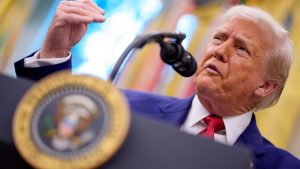
Tariffs are a tool used by both the President-elect Donald Trump during his first term and the current Biden administration. But do they work? Not even ag economists are in alignment, as the answer seems to be: It depends.
Trump didn’t shy away from his tariff stance on the campaign trail. He reinforced his plan to impose a 10% tariff on all imported goods and a 60% tariff on goods from China. And his latest threat is against Mexico, saying he will implement a 25% tariff on imports from Mexico if they don’t secure the border. Mexico is now threatening to fight back with tariffs of its own.
Trump has talked about increasing tariffs on foreign goods, particularly those from China. He has argued such import taxes would keep manufacturing jobs in the U.S., shrink the federal deficit and help lower food prices.
As Trump makes his key cabinet and advisory picks at a historic pace, the Financial Times reported last week that Robert Lighthizer could make an encore performance as the U.S. Trade Representative (USTR), and if his previous track record is any indication of what’s to come, tariffs will be a tool used by the Trump administration again.
“Trump and Bob Lighthizer are two peas in a pod when it comes to using tariffs to get what they want in among our trading allies,” says Jim Wiesemeyer, Farm Journal Washington Correspondent.
So, that begs the question: do tariffs work?
It’s something Farm Journal asked the nearly 70 ag economists that are part of the Farm Journal Ag Economists’ Monthly Monitor. The survey asked economists: “Do tariffs work in trade policy?” Economists views were mixed:
- “Tariffs can work in trade policy — that’s why nations continue to use them. The complex part that extends beyond the tariff action is potential long-term repercussions that can result from trade flow changes.”
- “In limited cases, typically only if they result in a policy response in the targeted country. Much of the time, tariffs are like cutting off one’s nose to spite one’s face.”
- “Tariffs provide short-term gains but have always failed relative to free trade in the long term.”
- “Absolutely, when properly applied.”
- “Not over the long term. They tend to affect who gets to supply different markets around the world.”
The Ag Economists’ Monthly Monitor also asked: “When tariffs are used as a ‘tool’ in trade, who pays the tariff?” Not all economists were aligned on that answer either, saying sometimes it’s farmers and consumers, but it can also be the exporting countries.
- “When the U.S. imposes tariffs on imports, importers in the U.S. pay taxes to the U.S. government on their purchases from abroad. When another nation imposes tariffs, importers in that nation pay import taxes to their government on their purchases from abroad. Often, when a tariff is implemented, another nation retaliates, and you end up with importers in both nations paying the price on whatever products the tariffs apply toward.”
- “If an importing country places a tariff on the exporting country, producers in the exporting country and consumers in the importing country both lose (i.e., receive lower and higher prices, respectively). Conversely, producers in the importing country and consumers in the exporting country win (i.e., receive higher and lower prices, respectively).”
- “In the short run, consumers who purchase goods with a tariff might see higher prices if the tariff is not absorbed elsewhere. In the long run, the tariff might result in changes to the supply chain that result in higher prices but also create other economic opportunities in America (e.g. reshoring of domestic manufacturing).”
- “The correct economist answer is: It depends. Tariffs drive a wedge between prices in the exporting country and in the importing country. It depends on the circumstances of particular markets and how much is reflected in higher prices in the importing country and reduced prices in the exporting country.”
- “Both the exporting nation and the importing consumer pay some portion of the tariff depending on who has more flexibility to adjust to trade barrier. If exporting countries can easily switch to supplying other markets, they won’t have to ‘pay.’ If consumers can easily find cheap substitute goods, they won’t have to pay.”
Trump Threatened Tariffs on Deere
During a policy roundtable in Smithton, Pa., organized by the Protecting America Initiative this fall, Trump made significant statements regarding John Deere and its plans to move some production to Mexico. Trump threatened to impose a 200% tariff on John Deere products if the company proceeds with its plan to relocate some of its manufacturing operations to Mexico.
“I’m just notifying John Deere right now. If you do that, we’re putting a 200% tariff on everything that you want to sell into the United States,” Trump says. “So that if I win, John Deere is going to be paying a 200%. They haven’t started it yet. Maybe they haven’t even made the final decision yet. But I think they have — John Deere is going to and anybody else that does this because it’s hurting our farmers. It’s hurting our manufacturing.”
Farm Journal asked economists the likely outcome if Trump did follow through with tariffs. Here’s what they said:

You can now read the most important #news on #eDairyNews #Whatsapp channels!!!
🇺🇸 eDairy News INGLÊS: https://whatsapp.com/channel/0029VaKsjzGDTkJyIN6hcP1K

























